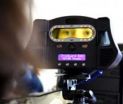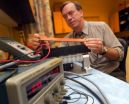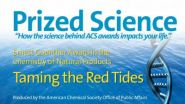(Press-News.org) The field that these researchers are working in is known by its nickname, "anti-spoofing", and basically consists in trying to detect all of the possible attempts at fraud that a biometric system might suffer, especially with regard to an action in which the user presents the biometric proof to the system. "What we are trying to do is detect those attempts so that the system can then act accordingly", explains the head of UC3M's Grupo Universitario de Tecnologías de Identificación (GUTI)(University Identification Technology Group), Raúl Sánchez Reíllo, who is leading this research. This way, if someone used a colored contact lens to recreate a specific iris at an access control point, the system would detect this possible fraud attempt and would indicate to this user that s/he could not use the automatic system and would have to use the manual identification system, with a security agent, for example.
These scientists work on "anti-spoofing" related to most of the forms of biometric identification. In addition, they evaluate the strength of current biometric systems in the face of various types of attacks, and they also create algorithms, devices and collateral techniques and usage policies that avoid and detect these attempts at fraud. " Currently, we are working very intensely on the ocular iris as well as written signatures, although previously we have worked on fingerprints, and in the near future we will be working on facial recognition", comments this professor from UC3M's Electronic Technology Department (Departamento de Tecnología Electrónica de la UC3M), pointing out that the challenges in this field are enormous. The reason: there is a constant struggle between "good" and "evil", in which the latter is constantly trying to find new ways to attack the security of the system. "Let's say that the good guys work to stay a step ahead of those attempts, introducing anti-fraud measures in advance of what the bad guys might come up with ", he reveals.
At a recent scientific conference, the scientists of the GUTI group presented part of their research on sources of noise and the most common falsifications in recognition systems based on iris identification. The article, titled "Estudio de la Casuística de la Muestras de Entrada en los Sistemas de Reconocimiento mediante Iris Ocular" ("A Case Study of the Entrance Samples in Recognition Systems Based on the Ocular Iris") presented at the V Jornadas de Reconocimiento Biométrico de Personas JRBP2010 (Fifth Conference on Biometric Recognition of Individuals JRBP2010) held in Huesca in early September, concluded that the robustness of the recognition algorithm and the inclusion of antifraud mechanisms in it are essential to keeping falsifications such as impressions of photographs of the iris, prostheses, or contact lenses from successfully violating the security of the systems.
Different types of fraud
Many of the attempts at fraud in biometric identification can be seen in films, although some of these definitely belong to world of science fiction. One that is actually feasible, according to the researchers, is the reproduction of fingerprints using silicone or other plastics, while cutting off a person's finger or hand in order to use his/her fingerprint or hand geometry for identification purposes would only work with systems that are in the lowest range. In contrast, using contact lenses with the iris painted on them is usually detectable, and removing someone's eyeball is useless, as the eye deteriorates very quickly, according to the scientists. In the case of facial recognition, using make-up to take on the appearance of another does not usually work, while the use of masks or plastic surgery is sometimes successful.
The university's GUTI research group also carries out periodic, independent evaluations of these systems, in order to identify the strengths and weaknesses of new developments to the manufacturers, as well as to analyze the usability of the systems, to see if users feel comfortable with them. This is because, according the researchers, systems for identifying people, whether they use documents, biometrics or both, should not be seen as simple security tools, but as a way to bring technology closer to the user, so that the user can work more easily with automatic services.
Currently, biometric systems are being used with greater frequency in both banking and commercial applications. The biometric identification system par excellence, and the most widely used, is the fingerprint system, although techniques such as vascular identification are starting to be used in hospitals and automatic teller machines, where they could substitute or complement intelligent cards or fingerprints. In fact, in Japan, a large number of automatic teller machines have already been adapted to use this type of identification, although their current rate of use is still below ten percent, as the process introduction process is still in progress, explains Sánchez Reillo. Another important biometric technique uses the iris. This system offers a very low rate of 'false rejections' (that is, when the system does not recognize you although you are the correct person) and, at the same time, its rate of 'false acceptance' (when you are not the correct person, but the system accepts you) is practically zero. However, both the computational costs and the economic costs of this system are high compared to other techniques such as vascular or fingerprint.
There are other interesting biometric applications in existence, such as multimodal systems, in which various different techniques are used– fingerprints and the vascular system, for example – the data are merged and, based on the results obtained so far, the rate of success is even higher. Hybrid systems can also be developed by combining technologies, and can then be used in automatic teller machines depending on the amount of money to be withdrawn. For example, if the user wishes to withdraw three hundred euros, s/he can use a PIN number for identification; however, if s/he wants to withdraw a greater amount of money, the system may require the user to identify him/herself using the veins in his/her hands.
INFORMATION:
Research on avoiding fraud in biometric identification
2010-10-26
ELSE PRESS RELEASES FROM THIS DATE:
Beauty from the bottom up
2010-10-26
Flamingos apply natural make-up to their feathers to stand out and attract mates, according to a new study by Juan Amat, from the Estación Biológica de Doňana in Seville, Spain, and colleagues. Their research is the first to demonstrate that birds transfer the color pigments (carotenoids) from the secretions of their uropygial gland for cosmetic reasons. The uropygial or preen gland is found in the majority of birds and is situated near the base of the tail. The study is published online in Behavioral Ecology and Sociobiology, a Springer journal.
There is evidence ...
Daily vibration may help aging bones stay healthy
2010-10-26
AUGUSTA, Ga. - A daily dose of whole body vibration may help reduce the usual bone density loss that occurs with age, Medical College of Georgia researchers report.
Twelve weeks of daily, 30-minute sessions in 18-month old male mice – which equate to 55- to 65-year-old humans – appear to forestall the expected annual loss that can result in fractures, disability and death. Dr. Karl H. Wenger, biomedical engineer in the MCG Schools of Graduate Studies and Medicine, reported the findings with his colleagues in the journal Bone.
Researchers found vibration improved density ...
Plant stem cells could be fruitful source of low-cost cancer drug
2010-10-26
A popular cancer drug could be produced cheaply and sustainably using stem cells derived from trees, a study suggests.
Researchers have isolated and grown stem cells from a yew tree whose bark is a natural source of the anticancer compound paclitaxel. The development could enable the compound to be produced on a commercial scale at low cost, with no harmful by-products.
Scientists and engineers behind the development say the drug treatment – currently used on lung, ovarian, breast, head and neck cancer – could become cheaper and more widely available.
The study was ...
Radiation before surgery keeps colorectal cancer from returning
2010-10-26
Patients with cancer found at the end of the large intestine called the rectum who receive one week of radiation therapy before surgery have a 50 percent reduction in chance that their cancer will return after 10 years, according to a large, randomized study presented at the plenary session, November 1, 2010, at the 52nd Annual Meeting of the American Society for Radiation Oncology (ASTRO).
"We believe that this short course of radiation will open a new window of opportunities in the treatment of rectal cancer," Corrie Marijnen M.D., lead author of the study and a radiation ...
Aspirin use associated with lower risk of cancer death for men with prostate cancer
2010-10-26
Men with prostate cancer who take anticoagulants like aspirin in addition to radiation therapy or surgery may be able to cut their risk of dying of the disease by more than half, according to a large study presented on November 3, 2010, at the 52nd Annual Meeting of the American Society for Radiation Oncology (ASTRO) in San Diego. The study involved more than 5,000 men with localized cancer whose disease had not spread beyond the prostate gland.
"Evidence has shown that anticoagulants may interfere with cancer growth and spread," Kevin Choe, M.D., Ph.D., lead author of ...
Prostate cancer screening improves quality of life by catching disease before it spreads
2010-10-26
Men treated for prostate cancer who were diagnosed after the start of routine screening had a significantly reduced risk of the disease spreading to other parts of the body (metastases) within 10 years of treatment, compared to men who were treated prior to the use of routine screening, according to the first study-of-its-kind presented November 1, 2010, at the 52nd Annual Meeting of the American Society for Radiation Oncology (ASTRO).
In 1993, routine prostate cancer screening became widely implemented through the use of a prostate specific antigen (PSA) test that was ...
Adding radiation to hormone therapy for prostate cancer treatment will increase survival chances
2010-10-26
Prostate cancer patients who are treated with a combination of hormone therapy and radiation have a substantially improved chance of survival compared to patients who do not receive radiation, according to interim results of the largest randomized study of its kind presented at the plenary session, November 1, 2010, at the 52nd Annual Meeting of the American Society for Radiation Oncology (ASTRO).
From 1995 to 2005, 1,205 men with high-risk prostate cancer in the United States, the United Kingdom and Canada were randomly selected to receive hormone therapy alone or a ...
New American Chemical Society Prized Science video focuses on 'green gasoline'
2010-10-26
WASHINGTON, Oct. 25, 2010 — Green gasoline is plants in your tank, motor vehicle fuel made from corn, cornstalks, sugarcane, and other crops. It also is gasoline made with recipes that reduce the need for harsh, potentially toxic ingredients like hydrofluoric acid or sulfuric acid that are used at about 210 oil refineries worldwide. Now scientists have found an answer to a half-century quest for a way to make gasoline in exactly that kind of greener, more environmentally-friendly way.
That advance highlights the second episode of a new video series, Prized Science: ...
Highly targeted radiation technique minimizes side effects of prostate cancer treatment
2010-10-26
Men with prostate cancer treated with a specialized type of radiation called intensity modulated radiation therapy (IMRT) have fewer gastrointestinal complications compared to patients treated with conventional three-dimensional conformal radiotherapy (3D-CRT), according to a study presented November 1, 2010, at the 52nd Annual Meeting of the American Society for Radiation Oncology (ASTRO).
"With survivors living many years after treatment, it is very important to minimize gastrointestinal and urinary side effects to allow patients to live a full life after treatment," ...
Newer, more intense chemotherapy with less radiation not more effective against Hodgkin's lymphoma
2010-10-26
A lower dose of radiation used to reduce side effects is not as effective as the regular dose when given with the standard chemotherapy in the treatment of Hodgkin's lymphoma patients with early, intermediate-stage disease, according to a first-of-its-kind randomized study presented at the plenary session, November 1, 2010, at the 52nd Annual Meeting of the American Society for Radiation Oncology (ASTRO).
In addition, the trial showed that a more intensive chemotherapy (BEACOPP) is not more effective than the standard chemotherapy treatment (ABVD) for these patients.
"This ...


